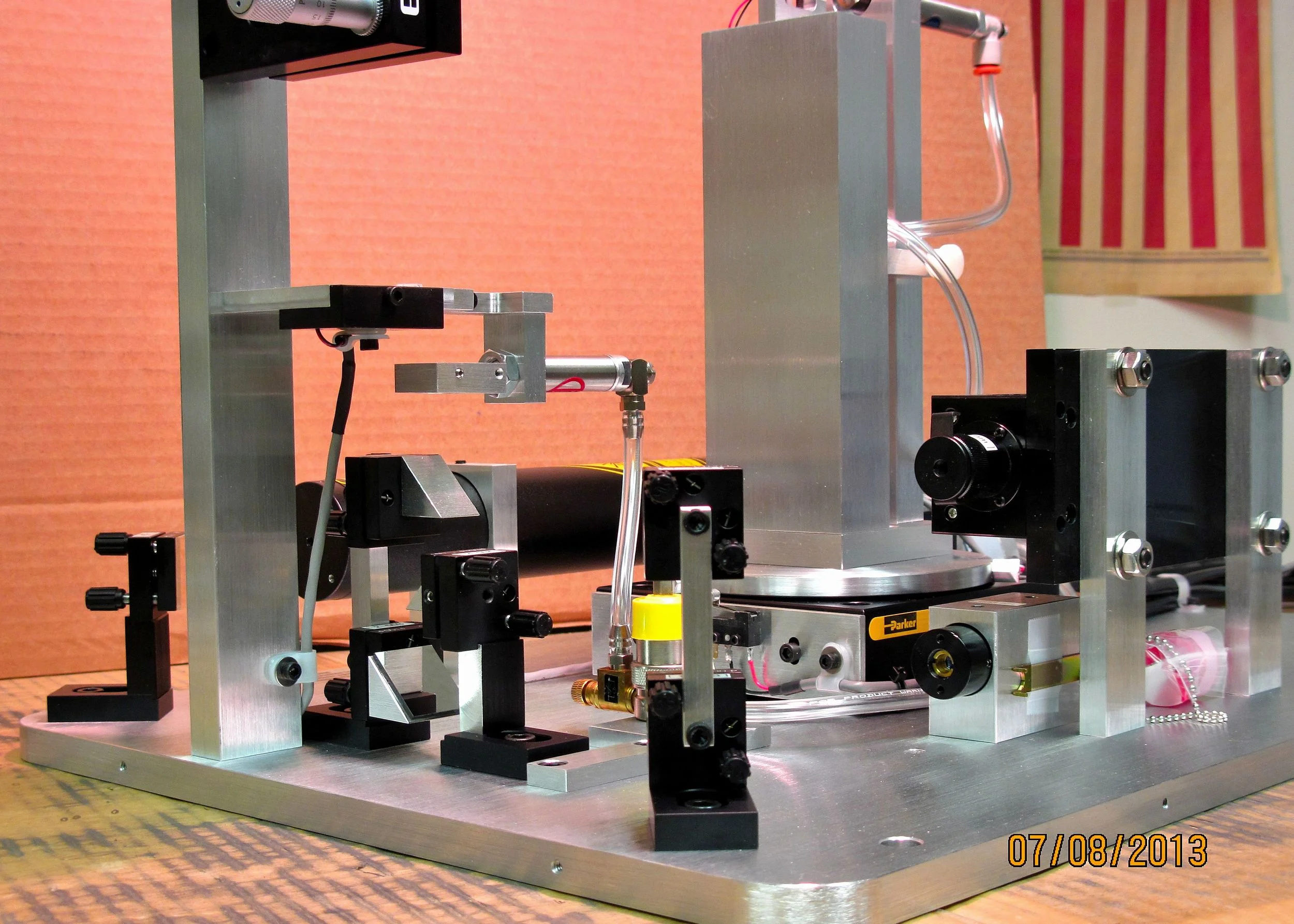Bulk Material or Thick Film Index/Birefringence Measurement
The Model 2010/M can operate as a fully-automated refractometer, providing high accuracy measurement of refractive index and index anisotropy for solid or liquid bulk materials and thick films in the index range 1.0 -2.6 without use of toxic or corrosive index matching fluids. This bulk material index measurement is not an option, but a standard feature provided with every system.
Index of materials thicker than 10 microns (0.4 mil) is easily analyzed by the 2010/M’s bulk index measurement mode. In this mode, the 2010/M simply senses the critical angle at the interface between the prism and the material in contact with the prism:
The Model 2010/M determines the critical angle automatically and since np is well known, the film index is easily determined from equation (1).
This same approach can also be used to measure refractive index for thick films. In the case of a film, the critical angle of the prism/film interface establishes an upper limit to the angle at which film propagation modes can occur. As a film with fixed index gets thicker, the angle at which the first propagation mode occurs asymptotically approaches the critical angle as defined by equation (1) where n now refers to the film index rather than to a bulk index. If we make the approximation that the angle of the first film mode equals the critical angle, the error in the measured index due to this approximation is less than .004 for a film thickness of 3 microns, less than .001 at 5 microns, and less than .0003 at 10 microns. Thus, this approach can be applied with good accuracy to measure the index of materials with thickness ranging from several microns on up to “bulk” thickness.
For measurement of liquid samples, a cell to bring the liquid in direct contact with the prism is available.
The bulk index approach can also be used to study index anisotropy in solid materials. In normal operation (Fig. 2a), the Model 2010/M uses a polarized laser with TE incidence, i.e., electric field vibrating transverse to the plane of incidence (out of the plane of Fig. 1 and in the plane of Fig. 2 in the vertical direction). Thus, if the material in figure 1 is simply manually rotated against the prism (Fig. 2b), the electric field vector can be made to assume any orientation within the plane defined by the surface of the material, and the index for electric field vibration along any axis lying parallel to the material surface can be measured.
In addition, with option #2010-TM, which rotates the laser polarization 90 degrees and provides TM incidence (magnetic field transverse to, and electric field parallel to, the plane of incidence), index perpendicular to the material surface can be measured. (Fig. 2c). This is because the electric field vibrates perpendicular to the material surface at the critical angle since the refracted ray must propagate parallel to the surface at the critical angle.
- Operation: In the bulk index mode, the angle of incidence on the sample/prism interface is varied using a motor-driven rotary table until a sharp drop is detected on the detector. The system software then calculates and displays bulk index from equation (1).
- Accuracy and resolution: With the high resolution rotary table (a no-cost option), worst case index accuracy is ±.001 and resolution is ±.0001 for bulk materials and films thicker than 10 microns. Absolute accuracy can be improved to approximately ±.0001, however, if the user is willing to perform a simple calibration procedure (measurement of an absolute index standard) with each prism. Accuracy decreases with film thickness, with measured index systematically low by .001 at 5 microns, and by .003-.004 at 3 microns.
- Measurement time: Typical measurement time is 10-20 seconds.
- Index measuring range: Minimum and maximum index measurable varies with prism type selected: 1.00-1.80 (200-P-1), 1.20-2.00 (200-P-4) and 1.55-2.45 (200-P-2 prism). Special 200-P-2 prisms are available to extend measuring range up to approximately 2.60 for visible wavelengths and silicon prisms are available to extend the measuring range up to 3.35 for wavelengths above 1100 nm.
- Dispersion (index vs wavelength): Unlike most conventional refractometers, which are single wavelength (typically 589 nm), the 2010/M can be equipped with as many as five lasers, allowing easy measurement of dispersion across a wide wavelength range. After index is measured at three or more wavelengths, the Model 2010/M fitting software generates an extremely accurate curve of index vs wavelength in only a few seconds.
Measurement of ordinary and extraordinary indices of bulk lithium niobate




